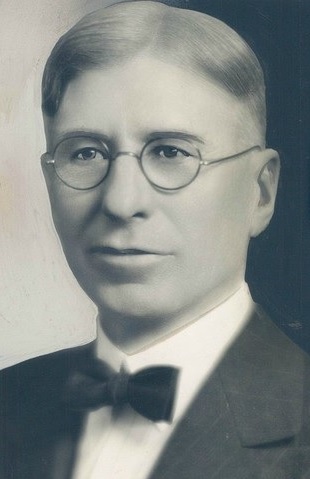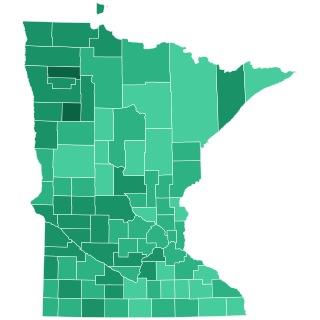
Elmer Austin Benson was an American lawyer and politician from Minnesota. In 1935, Benson was appointed to the U.S. Senate following the death of Thomas Schall. He served as the 24th governor of Minnesota, defeating Republican Martin Nelson in a landslide in Minnesota's 1936 gubernatorial election. He lost the governorship two years later to Republican Harold Stassen in the 1938 gubernatorial election.

Thomas David Schall was an American lawyer and politician. He served in both the United States House of Representatives and the United States Senate from Minnesota. He was initially elected and then re-elected as a Progressive but later joined the Republican Party.

The first modern Farmer–Labor Party in the United States emerged in Minnesota in 1918. The American entry into World War I caused agricultural prices and workers' wages to fall, while retail prices rose sharply during the war years. Consequently, farmers and workers made common cause in the political sphere to redress their grievances.

Einar Hoidale was an American lawyer, newspaper editor and elected official. He served as a member of the United States House of Representatives during the 1930s.

The 1936 United States Senate elections coincided with the reelection of President Franklin D. Roosevelt. The 32 seats of Class 2 were contested in regular elections, and special elections were held to fill vacancies. The Great Depression continued and voters backed progressive candidates favoring Roosevelt's New Deal in races across the country. The Democrats gained 5 net seats during the election, and in combination with Democratic and Farmer–Labor interim appointments and the defection of George W. Norris from the Republican Party to become independent, the Republicans were reduced to 16 seats. The Democrats' 75 seats and their 59-seat majority remain their largest in history.

Quentin Northrup Burdick was an American lawyer and politician. A member of the North Dakota Democratic-NPL Party, he represented North Dakota in the U.S. House of Representatives (1959–1960) and the U.S. Senate (1960–1992). At the time of his death, he was the third longest-serving senator among current members of the Senate.
The following table indicates the party of elected officials in the U.S. state of Minnesota:

Floyd Bjørnstjerne "Skipper" Olson was an American politician and lawyer. A three-term governor, he served as the 22nd Governor of Minnesota from January 6, 1931, to August 22, 1936, when he died in office. Olson was a member of the Minnesota Farmer–Labor Party, and the first member of that party to win the office of governor. He was a prominent governor of Minnesota and an influential American politician.

The 1934 United States Senate election in Minnesota took place on November 6, 1934. Incumbent Farmer–Labor U.S. Senator Henrik Shipstead defeated former State Senator Nathaniel J. Holmberg of the Republican Party of Minnesota and U.S. Representative Einar Hoidale of the Minnesota Democratic Party to win a third term.

The 2014 Minnesota Attorney General election was held on November 4, 2014, to elect the Minnesota Attorney General.

The 1942 United States Senate election in Minnesota took place on November 3, 1942. Incumbent Republican Joseph H. Ball, who had been temporarily appointed by Governor Harold Stassen in 1940 to fill the seat of the deceased Farmer–Labor U.S. Senator Ernest Lundeen, defeated Farmer–Labor former U.S. Senator and former Governor Elmer Benson, independent candidate Martin A. Nelson, and Democratic nominee Ed Murphy, to win election to the full six-year term beginning in January 1943. A special election held on the same date elected Republican nominee Arthur E. Nelson to serve the remainder of Lundeen's unexpired term.

A general election was held in the U.S. state of Minnesota on November 6, 2018. All of Minnesota's executive officers were up for election as well as all the seats in the Minnesota House of Representatives, several judicial seats, two United States Senate seats, Minnesota's eight seats in the United States House of Representatives, and several seats for local offices. Special elections were also held for a Minnesota Senate seat and Minnesota's Class 2 U.S. Senate seat. A primary election to nominate Republican and Democratic–Farmer–Labor (DFL) candidates and several judicial and local primary elections were held on August 14, 2018.

The 1922 United States Senate election in Minnesota took place on November 7, 1922. Farmer–Labor challenger Henrik Shipstead defeated incumbent Republican U.S. Senator Frank B. Kellogg and Democratic challenger Anna Dickie Olesen.

The 1923 United States Senate special election in Minnesota took place on July 16, 1923. The election was held to fill, for the remainder of the unexpired term, the seat in the United States Senate left vacant by Republican U.S. Senator Knute Nelson, who died in office on April 28, 1923. State Senator Magnus Johnson of the Farmer–Labor Party of Minnesota defeated Governor J. A. O. Preus of the Republican Party of Minnesota, and State Senator James A. Carley of the Minnesota Democratic Party, which, together with Henrik Shipstead's victory in 1922, brought both of Minnesota's seats in the United States Senate into the hands of the Farmer–Labor Party for the first time in history.

The 1924 United States Senate election in Minnesota took place on November 4, 1924. Republican U.S. Representative Thomas D. Schall defeated incumbent Farmer–Labor U.S. Senator Magnus Johnson and Democratic challenger John J. Farrell. Johnson, who was elected in the 1923 special election, had been in office for less than a year and a half when his attempt to win a full six-year term was defeated by Schall.

The 1928 United States Senate election in Minnesota took place on November 6, 1928. Incumbent Farmer–Labor U.S. Senator Henrik Shipstead defeated his Republican challenger, former St. Paul mayor Arthur E. Nelson, to win a second term.

The 1930 United States Senate election in Minnesota was held on Tuesday November 4, Incumbent Senator Thomas D. Schal defeated Einar Hoidale of the Minnesota Democratic Party and Forner United States Representative Ernest Lundeen of the Farmer–Labor Party of Minnesota to win a second term.

The 1936 United States Senate election in Minnesota took place on November 3, 1936. Incumbent Farmer–Laborite Elmer A. Benson, who had been temporarily appointed by Governor Floyd B. Olson in 1935 to fill the seat of the deceased Republican U.S. Senator Thomas D. Schall, opted to run for Governor rather than seek election to a full term or to fill the remainder of the unexpired term. Governor Olson won the Farmer–Labor primary for nomination to the full Senate term, but died of stomach cancer prior to the general election. In Olson's place, the Farmer–Labor Party ran U.S. Representative Ernest Lundeen, who went on to defeat former Governor Theodore Christianson of the Republican Party of Minnesota in the general election. A special election held on the same date elected Republican nominee Guy V. Howard to serve the remainder of Schall's unexpired term.

The 1940 United States Senate election in Minnesota took place on November 5, 1940. Incumbent U.S. Senator Henrik Shipstead defected to the Republican Party of Minnesota from the Farmer–Labor Party of Minnesota, and defeated former Governor Elmer Benson of the Farmer–Labor Party and John E. Regan of the Minnesota Democratic Party to win a fourth term.

The 1936 Wisconsin gubernatorial election was held on November 3, 1936.
























